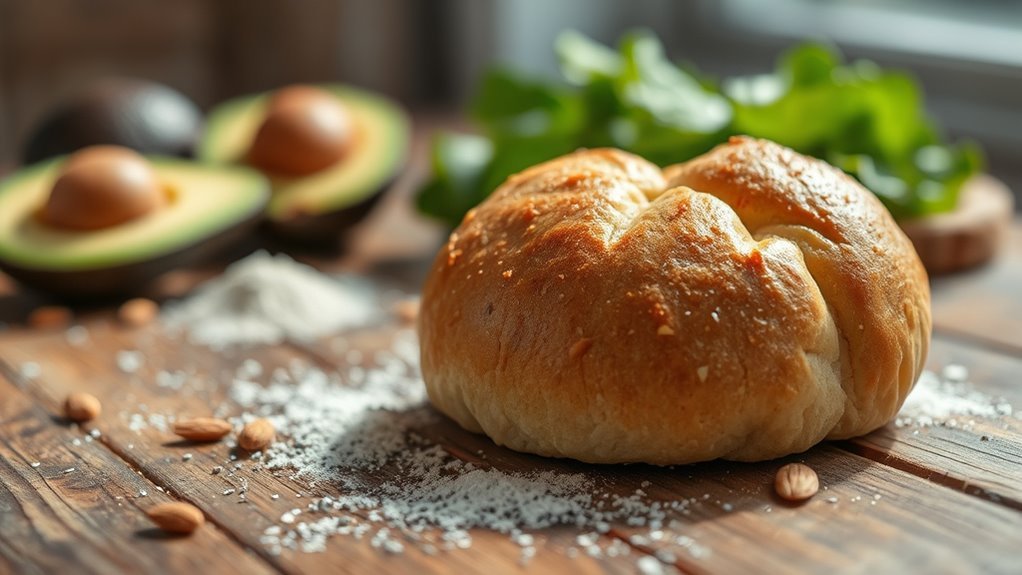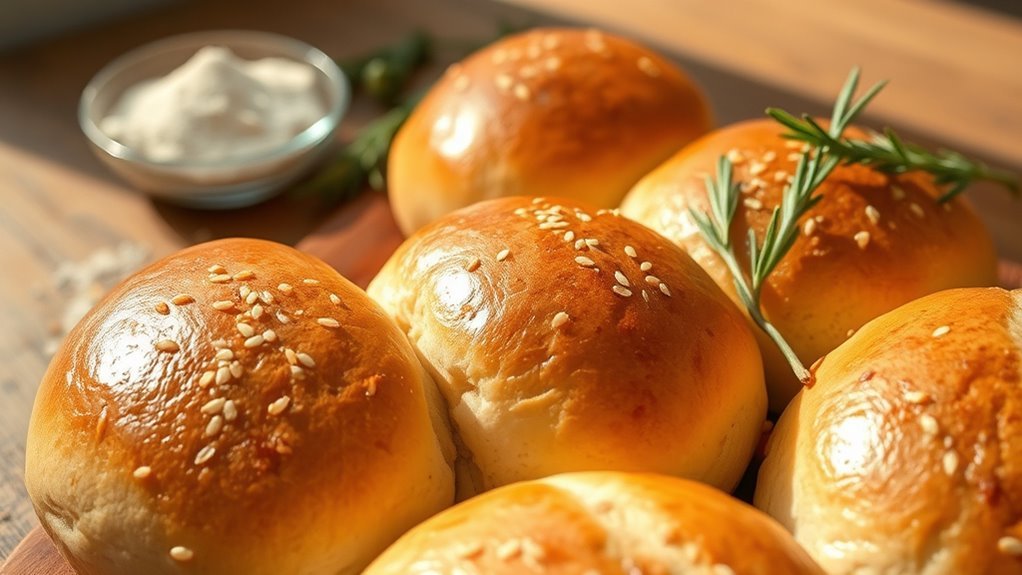Yes, keto buns can be gluten-free, depending on their ingredients. Many keto buns use almond flour, coconut flour, and psyllium husk, which are naturally gluten-free alternatives. However, it’s important to check the label for gluten-free certification, as some brands may still have cross-contamination risks. Look for buns without wheat, barley, or rye ingredients. By choosing the right brands and recipes, you can enjoy gluten-free keto buns without sacrificing flavor or nutrition. There’s more to explore about making your choices!
Understanding Keto Buns: What Are They Made Of?

Keto buns are a popular alternative for those following a ketogenic diet, providing a low-carb option that satisfies bread cravings. You’ll find various keto bun types, each crafted from unique ingredients to keep carbs low while offering flavor and texture. Common ingredients include almond flour, coconut flour, and psyllium husk, which help create a satisfying bun without gluten. If you’re looking to customize your bun experience, ingredient substitutions can easily be made. For instance, you might swap almond flour for sunflower seed flour if you’re nut-free. This flexibility allows you to enjoy your favorite dishes without sacrificing your dietary goals, giving you the freedom to indulge while staying true to your lifestyle.
Common Ingredients in Keto Buns

When exploring the world of keto buns, it’s important to understand the common ingredients that make them a viable bread substitute. These ingredients not only offer nutritional benefits but also allow for various flavor variations.
Here’s a quick overview of some popular ingredients:
| Ingredient | Nutritional Benefits | Flavor Variations |
|---|---|---|
| Almond flour | Low-carb, high in fiber | Nutty, slightly sweet |
| Coconut flour | High in healthy fats | Tropical, mild sweetness |
| Psyllium husk | Supports digestion | Neutral, enhances texture |
| Cheese | High in protein | Savory, rich |
| Eggs | Nutrient-dense | Neutral, binds ingredients |
These components help you create delicious, gluten-free options that satisfy your cravings while sticking to your keto lifestyle.
Gluten-Free Grains and Alternatives

While many traditional grains are off-limits on a keto diet, there are several gluten-free grains and alternatives that can fit into your low-carb lifestyle. These options include almond flour, coconut flour, and flaxseed meal, which offer varying taste profiles and texture variations for your baking alternatives. They not only serve as gluten-free grains but also provide essential fiber sources and nutrient density. You can easily incorporate these low-carb options into your favorite recipes, allowing you to enjoy the freedom of baking without compromising your dietary preferences. Grain substitutes like psyllium husk can enhance texture while keeping your carb count low. Embrace these alternatives to maintain a satisfying and healthy keto diet that suits your lifestyle.
Popular Keto Bun Brands: A Comparison
With numerous options available, choosing the right keto bun brand can greatly impact your low-carb meals. Popular brands like Sola, ThinSlim, and Franz offer unique flavors and textures, but consumer reviews vary widely. Nutritional comparisons reveal differences in carbs, fiber, and protein content, so you’ll want to evaluate what aligns with your dietary goals. Taste tests often highlight Sola for its bread-like texture, while ThinSlim is praised for its low-calorie count. Price points can also vary, which may pose availability issues depending on your location. Pay attention to ingredient sourcing, as some brands emphasize natural ingredients, enhancing health benefits. Ultimately, finding a keto bun that meets your taste and nutritional needs will elevate your meal experience.
Reading Labels: How to Identify Gluten-Free Options
Choosing the right keto bun brand isn’t just about taste and nutrition; it’s also essential to guarantee that the options you select are truly gluten-free. Effective label reading is your best ally in gluten detection. Here are three key points to reflect upon when checking labels:
When choosing keto buns, prioritize gluten-free certification and ingredient transparency for safe options.
- Gluten-Free Certification: Look for products that carry a gluten-free label from reputable organizations.
- Ingredient List: Pay attention to the ingredients; avoid those with wheat, barley, or rye.
- Cross-Contamination Warnings: Be cautious of any statements indicating potential cross-contamination with gluten-containing products.
Cross-Contamination: What You Need to Know
When it comes to gluten-free eating, understanding cross-contamination risks is essential. You’ll want to implement safe food handling practices, especially if you share a kitchen with gluten-containing products. Choosing certified gluten-free products can also help minimize the risk of accidental exposure.
Understanding Cross-Contamination Risks
How can you guarantee your keto buns remain gluten-free? Understanding cross-contamination risks is crucial for avoiding gluten exposure. Awareness of potential cross-contamination sources can help you enjoy your keto lifestyle without worry. Here are three common sources to take into account:
- Shared Cooking Surfaces: Utensils and cutting boards used for gluten-containing foods can transfer gluten residues.
- Packaging: Products that aren’t certified gluten-free might have been processed in facilities that handle gluten.
- Bread Machines: If you use a bread machine, make sure it’s been thoroughly cleaned from previous gluten-containing recipes.
Safe Food Handling Practices
While it might seem straightforward, safe food handling practices are crucial for preventing cross-contamination, especially in a gluten-free kitchen. To guarantee you’re enjoying your keto buns without worry, prioritize proper storage and hygiene measures. Always store gluten-free and gluten-containing products separately to minimize risks. Use dedicated utensils and cutting boards for gluten-free items to avoid any accidental contact. Regularly wash your hands and surfaces to maintain a clean environment. Remember, even small crumbs can lead to cross-contamination, so be vigilant. By adopting these safe food handling practices, you’re not just protecting your meals; you’re embracing the freedom to enjoy them without fear. Safety doesn’t just enhance your experience; it’s a critical part of a healthy lifestyle.
Certified Gluten-Free Products
Understanding the importance of certified gluten-free products is crucial for anyone adhering to a gluten-free diet, especially if you have celiac disease or gluten sensitivity. Certified products undergo a rigorous certification process that guarantees they meet specific gluten testing standards. Here are three key aspects to reflect on:
- Cross-Contamination Prevention: Certified products are produced in dedicated facilities, minimizing the risk of gluten exposure.
- Stringent Testing: Regular gluten testing confirms that products contain less than 20 parts per million of gluten, aligning with safety regulations.
- Labeling Assurance: Certified gluten-free labels provide peace of mind, helping you make informed choices without fear of hidden gluten.
Embracing certified options empowers you to enjoy your meals while maintaining your health and freedom.
Recipes for Homemade Gluten-Free Keto Buns
When you’re ready to whip up some homemade gluten-free keto buns, knowing the right ingredients is essential. You’ll want to choose low-carb flours and binders that keep your buns fluffy and delicious. Plus, mastering a few baking tips and techniques can make all the difference in achieving the perfect texture and flavor.
Ingredients for Keto Buns
Creating delicious gluten-free keto buns requires a careful selection of ingredients that align with both dietary restrictions and flavor preferences. To guarantee you enjoy the nutritional benefits and explore various flavor variations, consider these key ingredients:
- Almond Flour: A low-carb alternative packed with healthy fats and protein.
- Psyllium Husk: Adds structure and helps bind the ingredients while providing fiber.
- Eggs: Essential for moisture and binding, they also contribute to the bun’s fluffiness.
Baking Tips and Techniques
To achieve the perfect gluten-free keto buns, mastering a few baking tips and techniques can make all the difference. Start with the right ingredient substitutions, like almond flour instead of wheat flour, and guarantee you measure accurately. Here’s a handy table to guide you on common substitutions:
| Ingredient | Substitute | Ratio |
|---|---|---|
| Wheat Flour | Almond Flour | 1:1.5 |
| Sugar | Erythritol | 1:1 |
| Butter | Coconut Oil | 1:1 |
| Eggs | Flaxseed Meal + Water | 1:1 |
| Milk | Almond Milk | 1:1 |
Experimenting with these baking techniques not only enhances flavor but also keeps your buns fluffy and light. Enjoy the freedom of creating delicious keto buns!
Frequently Asked Questions
Can Keto Buns Be Made Without Almond Flour?
Sure, you can make keto buns without almond flour! Isn’t it ironic how we often think of just one option? Try using coconut flour or flaxseed meal instead. Coconut flour absorbs more moisture, so you’ll need to adjust your liquids accordingly. Flaxseed meal adds a nutty flavor and healthy omega-3s. With the right ratios, you’ll whip up delicious, gluten-free buns that fit perfectly into your keto lifestyle. Enjoy those carb-free creations!
Are All Keto Buns Naturally Gluten-Free?
Not all keto buns are naturally gluten-free. While many recipes use gluten-free alternatives like almond flour or coconut flour, some may include ingredients that contain gluten. It’s crucial to check the specific keto bun ingredients to verify they align with your dietary needs. If you’re looking for gluten-free options, consider buns made solely from non-wheat-based flours. Always read labels or make your own to enjoy the freedom of a gluten-free lifestyle.
Do Keto Buns Taste Similar to Regular Bread?
Keto buns don’t always taste like regular bread, but they can be quite enjoyable. You’ll find that the keto bun texture often differs, being denser or slightly chewier than traditional bread. However, many people appreciate the variety of keto bread flavors available, such as almond, coconut, or cheese. While they might not perfectly replicate the taste of regular bread, they still offer a satisfying alternative for those following a low-carb lifestyle.
How Do Keto Buns Affect Blood Sugar Levels?
Think of your blood sugar as a rollercoaster ride—keto buns can help keep it steady. Since they’re typically low in carbs, they generally cause a smaller insulin response compared to regular bread. This means you’re less likely to experience those sharp highs and lows in blood sugar. However, everyone’s body reacts differently, so it’s wise to monitor your levels and see how these buns fit into your unique dietary journey.
Can I Freeze Keto Buns for Later Use?
Yes, you can freeze keto buns for later use. To guarantee they maintain their quality, use proper freezing techniques like wrapping them tightly in plastic wrap or aluminum foil before placing them in a freezer bag. Label the bag with the date for easy identification. For best results, consume them within a month. When you’re ready to enjoy, simply thaw them in the fridge or toast them directly from the freezer for a quick meal.


